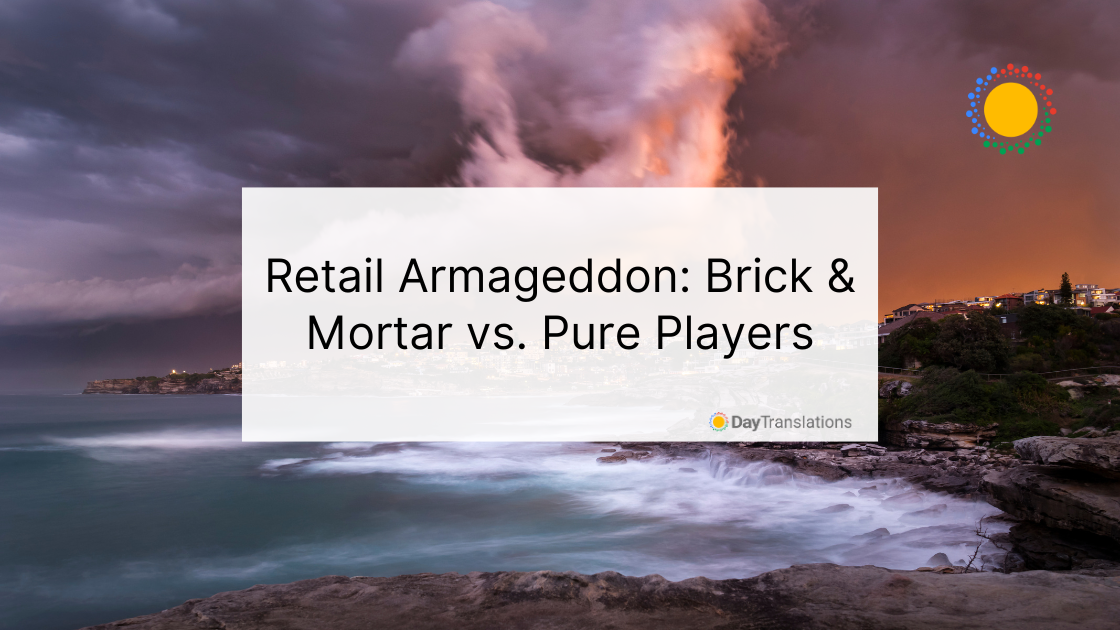Today’s retail marketplace is teeming with options for people to shop, creating a retail Armageddon that was started when Amazon acquired Whole Foods Market in August 2017. When the brick and mortar supermarket chain became part of a pure player, the retail landscape began to change.
Pure players and brick and mortar stores are implementing changes in the way they market their products and services, thus increasing competition and providing benefits to consumers. However, the trend now is for brick and mortar establishments developing their online presence while some of the pure players are establishing brick and mortar stores. Will this level the playing field for the retail market? Will there be a winner in the retail Armageddon or this is going to end?
What is brick and mortar?
Investopedia defines brick and mortar as a traditional business you find along the street. The business establishment does business face-to-face. Examples are banks, mom-and-pop stores, flower shops, barbershops, beauty salons and grocery stores. These types of establishments have higher operating costs that web-based companies or pure plays (pure players).
They do have some advantages over online businesses. Consumers still prefer to shop in places where they can directly deal with people. They want to receive comprehensive and quick responses to their questions regarding services and products. Consumers are able to hold, try and inspect products before they decide to make a purchase. A large number of consumers choose to try an item before buying. They associate the physical presence of a brick and mortar to legitimacy, which leads to consumers’ trust.
Moreover, consumers receive instant gratification after purchasing an item. Due to this, shoppers in brick and mortar stores spend more time inside, browsing other products because it gives them a social and sensory shopping experience.
Some of the main disadvantages of operating a brick and mortar store are paying for lease or rent, maintenance of employees who deal with customers and charges for utilities like water, gas and electricity.
What is a pure player?
Technically, a pure play (pure player) is a business term for an investment, business model or a company that serves a specific product, service, industry or distribution line. An example would be a company, let’s say a software company that makes only a single type of app. A consumer product company that sells just one type of item is a pure play company. Maytag is an example of a pure play company because it only manufactures commercial and home appliances. On the other hand, General Electric cannot be considered a pure play because while it manufactures commercial and home appliances, it also produces other products such as engines for vertical industries.
Several online retailers can be considered pure players because they only sell a specific type of product. If the interest in the product they sell is high they are financially rewarded, but if sales decline, it affects the company negatively.
You cannot say that only small online retailers carrying a single product are pure players, however. Some pure plays are large corporations. Starbucks Corporation is one because it’s a pure player in coffee. It is the same for Dunkin’ Brands Group, Inc. that owns Dunkin’ Donuts.
M. Smucker Company cannot be labeled a pure play company. It owns Medaglia D’Oro and Folger’s, which are major coffee brands. However, it also owns brands of jams, jellies and other edibles.
Because pure plays are dependent on one economic sector alone, they face risks because if the interest dips and consumption declines, they are financially affected. This is in contrast to diversified companies where some products may gain higher revenues, thus offsetting the lower sales of other products, keeping the bottom line in the black.
Will pure play online replace brick and mortar?
It does not seem likely that pure play will replace brick and mortar, which means that the retail Armageddon may be brought to a standstill. As it is, the retail scenario seems to be moving toward a convergence. Several reasons illustrate their differences, similarities and why they are heading for a convergence.
- The advantage of pure players is that they are more experienced in digital marketing than brick and mortar businesses. Mastery of digital space is an advantage for pure players. Brick and mortar businesses depend on their face-to-face encounters with consumers, leveraging the trust and loyalty given to them by their consumers and the tactile experience consumers prefer when they shop at brick and mortar stores.
- However, today’s consumers are using omnichannel means to buy products. So now, several brick and mortar retailers are investing on digital platforms as well to provide a solution to the omnichannel challenge.
- The two types of retailers differ in their strategic objectives to rein in the opportunities provided by the individual platforms they use for marketing. Pure players only use one channel to ensure the growth of their companies. Brick and mortar businesses, on the other hand, have their physical locations to drive their business as well as use their digital presence to boost their growth. Meaning the latter has two revenue channels to manipulate.
- In terms of digital marketing, pure players are at an advantage. Because they have mastered digital presence, they are more successful in making conversions. Their digital performance is better because they are born and bred in the digital world. They understood that customer experience is key, so their websites have easier logins and shorter load times. But the brick and mortar retailers are narrowing the gap because they have learned to turn customer experiences into the digital platform.
- Brick and mortar retailers with an online presence have been seen to have a better bounce rate and their page reach rate is higher. Users spend shorter time browsing each page, compared to pure players. This is due to the familiarity of the brick and mortar retailers with the brands and products they carry. Likewise, their customers also know what items they are looking for so they are more adept at finding these products. In digital parlance, online shoppers of the brick and mortar retailers spend less time using the search bar and rely more on the menu. Brick and mortar consumers can use two ways to shop – browse for the items online and go to the physical stores to buy.
- So now the retail playing field is leveling up. Many brick and mortar retailers are creating an online presence and pure players are expanding into physical stores to improve their services and use the omnichannel way as well.
How can brick and mortar retailers compete in the retail Armageddon?
They may have different approaches in marketing but these two types of retailers should understand that what is important is to provide what the consumers want, instead of what you want.
- Brick and mortar retailers have an advantage, because their physical stores provide the tactile experience most consumers want, which is something that pure players lack. Their digital presence can support other unique selling points such as ”click and collect” and ”reserve and collect.”
- They have a bigger (physical window) for their brand, compared to the size of a tablet, computer or smartphone screen.
- They should provide their employees with more tools to help them in customer acquisition, such as stock inventories. They should train their employees to be like pure players – being nimble, innovative and responsive to changes in processes.
- Pure players operate in niche markets. Therefore to be more competitive, brick and mortar businesses should do the same thing. They should avoid thinking that every item is good for every consumer. They will fare better by offering tailored products that cater to different tastes and needs.
- Brick and mortar stores should maximize the use of their physical presence. They should develop ways to increase consumer presence in their stores as well as their online platform and think of ways to increase customer loyalty. Many of these things, they already know. They should just enhance them, such as adding more value to their relationship with their customers – from in-store service, after-sales experience, personal assistance and perhaps, expert advice.
Enhancing customer experience
The digital age has opened the world and marketers have moved from selling locally to selling globally. This means that there are more markets to serve and more cultures to cater to. The global presence means that consumers speak different languages.
To improve customer experience and build loyalty, it is vital for marketers, whether they are pure players or brick and mortar businesses with an online presence to talk to their diverse consumer base in the language they understand.
Website localization services are becoming more important than ever as more markets are opened. Localization will make your websites adapt to local needs and preferences, in theme and tone, in color and voice. It will make your website look and feel local.
Global retailers also need subject matter experts, to ensure that you are providing the right kind of information using the right terminology and jargon. It is best to work with a professional translation company for your localization projects and provide you with a high-quality retail translation services.
Boost your sales through translation and localization
Whether you are a brick and mortar store or an online store, consumer loyalty and confidence should be on top of your marketing goals. What better way to achieve this than in providing your current and potential customers with the subliminal services that make them realize how you care for them. Providing information in the language they understand is one way to do it. You can also adapt your website to your target audiences through localization.
Get the best language services from Day Translations, Inc. With our native speaking professional translators and subject matter experts, you are assured that they fully understand local culture as well as the nuances of the language, thus you get high quality and accurate translation. They live in-country worldwide and available to provide you with language services at a moment’s notice. Give us a call anytime at 1-800-969-6853. You can also send us an email at Contact us. We are open 24/7, every day of the year because we understand that your need for language services cannot wait.
Image Copyright: Poohchisa Tunsiri / 123RF Stock Photo












Sorry, the comment form is closed at this time.